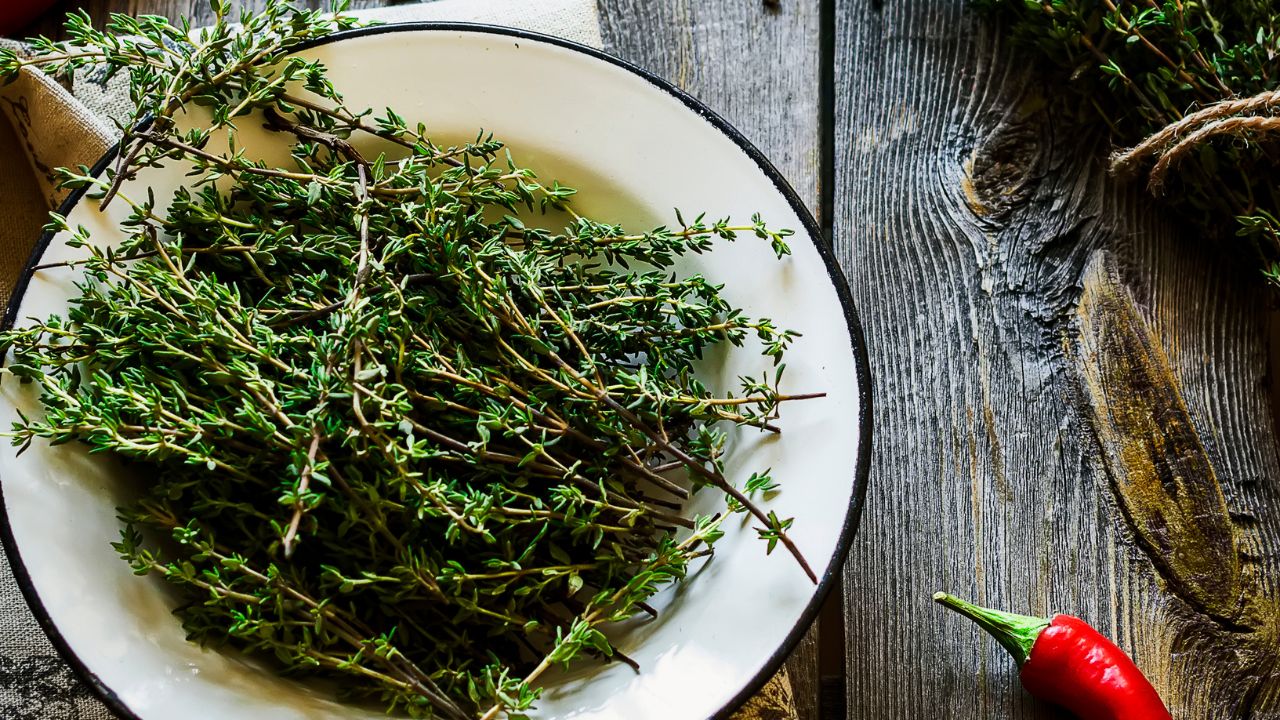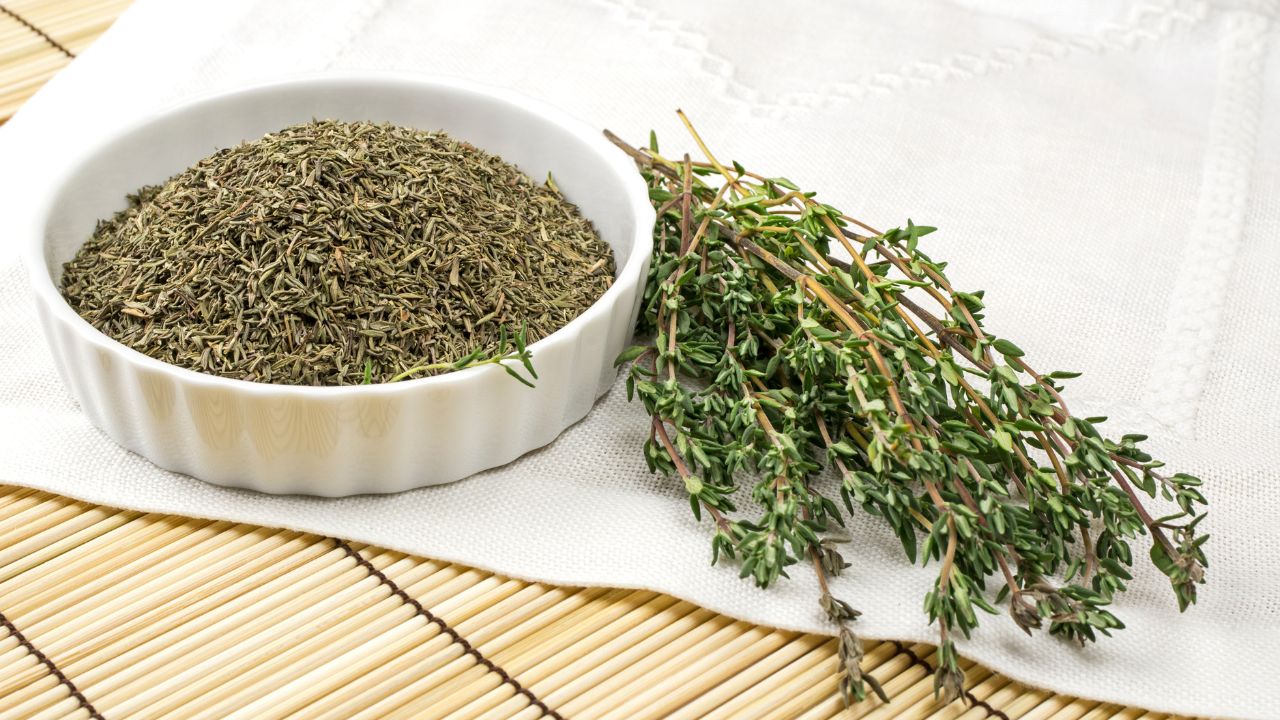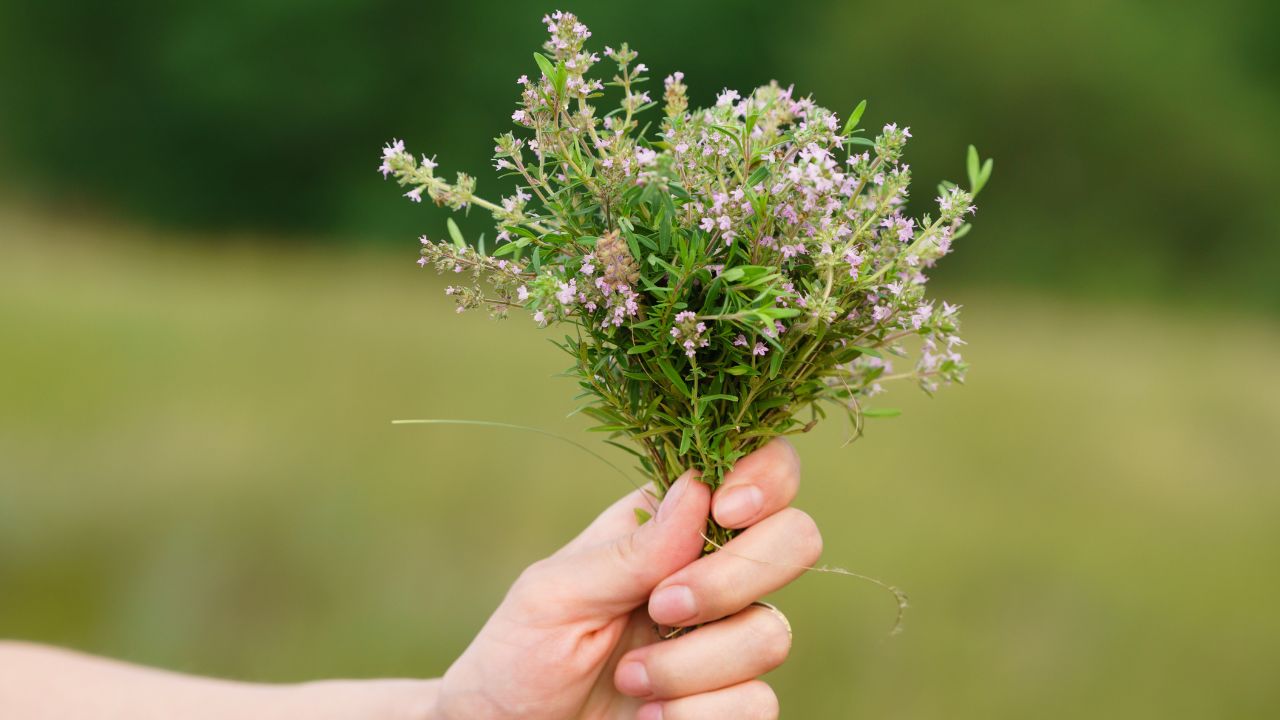Thyme is one of the most popular herbs used for seasoning in European and Mediterranean cuisine.
Personally, we can’t get enough of this flavorsome and aromatic herb.
One of the things that makes thyme such an established kitchen staple is the versatility of its flavor.
Despite being so distinct, the flavor of thyme can enhance many different types of dishes, so unlike other herbs and spices that might sit in the back of your pantry for years without being used, thyme is definitely worth picking up from the store.
With that being said, if you’re not sure what thyme tastes like, what the flavor difference is between fresh and dried thyme, and what recipes call for thyme, we’ve got all the information you’re looking for!

What Is Thyme?
If you don’t spend a lot of time cooking, you might not be sure exactly what thyme is.
Even if you’ve used thyme as part of a recipe before or have seen it listed in the ingredients of a dish you’ve ordered or purchased, you might not have a full understanding of where this seasoning comes from and what kind of plant it is.
For those who aren’t familiar, thyme is a herb that belongs to the mint family.
It’s similar to oregano in the sense that the two herbs are related, but it has its own distinctive flavor.
Thyme actually comes in more than one variety.
The two varieties of thyme you need to know about as a cook are common thyme (the most widely used) and lemon thyme, which is extra-aromatic and used when a dish requires additional flavor.
Because of the citrus-like flavor of lemon thyme, it’s often used in recipes that have other citrus ingredients in them.
Although thyme is most often thought of as a culinary herb, it also has medicinal properties.
For example, thyme is antibacterial and antiseptic, and it has also been used in the field of aromatherapy to stimulate both the circulatory and immune systems.
What Thyme Tastes Like?
Here’s the answer you came to this article to find.
The first step to knowing whether you want to incorporate any herb or spice into a dish is knowing what it tastes and smells like, so this is really important information.
As we mentioned earlier, there are two main varieties of thyme: common thyme and lemon thyme.
This means that the exact flavor of thyme will vary depending on which variety you choose.
Common thyme has a minty flavor, which is to be expected since it’s part of the mint family.
However, it is a sharp kind of mint as opposed to some of the softer mint flavors out there.
Compared to mint, it’s earthier and has a slightly peppery aftertaste although it manages to remain sweet.
Lemon thyme has an additional layer of citrus in its flavor profile, but it’s very subtle, which means that it can easily be blended with a variety of other herbs and spices without completely taking over.
Thyme Flavor: Dried Vs. Fresh

It’s fairly easy to find a little container of dried thyme in most grocery stores, but you may not be able to get your hands on a bunch of fresh thyme in every store you visit.
While you can certainly get away with using dried thyme in place of fresh thyme, there is a difference in the flavor, and it’s worth being aware of this if you’re serious about creating the perfect flavor experience.
Fresh thyme is definitely the better option in terms of flavor and nutritional value.
It doesn’t have a different flavor compared to dried thyme, but the flavor is noticeably stronger, and fresh thyme also contains more nutrients than the dried variety.
Therefore, if the flavor of thyme is going to be central to the dish you’re planning to cook, you should either use fresh thyme or make sure to add your dried thyme early in the cooking process to give the flavor (and the nutrients) more time to infuse.
If a recipe calls for fresh thyme and you only have dried thyme available, you may want to add a little extra.
Because thyme shrinks during the drying process, the measurements for dry and fresh time will also be different.
As a rule of thumb, for every ¼ tablespoon of dried thyme listed by a recipe, you should use about 2 tablespoons of fresh thyme.
Basically, you will need 8 times the recommended amount of dried thyme if you’re using fresh thyme, and of course, you will want to divide the amount of fresh thyme by 8 if you’re going to use dried thyme instead.
It’s also worth remembering that dried thyme will keep for longer than fresh thyme.
Fresh thyme can last for up to 2 weeks if refrigerated under the right conditions, but it often expires after about a week.
Conversely, dried thyme can continue to be used for up to a year.
Uses For Thyme

As we mentioned earlier, thyme is an extremely versatile herb, and that means it can be used to add flavor to a huge variety of dishes.
Something else we touched one earlier is the fact that thyme is most commonly used in European cuisine, including Mediterranean food.
The reason for its widespread popularity is that it’s able to infuse a dish with flavor without producing an overpowering effect.
First of all, it’s crucial to know which other herbs thyme pairs well with, and the good news is that thyme goes well with a wide variety of different herbs.
For example, the flavor works perfectly with basil, oregano, rosemary, parsley, tarragon, and chives.
None of these flavors overpower the taste of the thyme but they do lend their own flavors to dishes as well.
Thyme is frequently used to season meat-based dishes such as chicken, especially if the poultry has been braised, roasted or baked.
Pork, lamb, or beef-based meat dishes also often feature thyme as one of the seasonings. It’s even used to season seafood dishes such as fish soup, including clam chowder.
With that being said, the use of thyme isn’t limited to meat and fish (see also ‘What Does Catfish Taste Like?‘). It’s also an excellent herb for egg dishes like omelets and tomato salads.
Thyme even features in some drinks, including cocktails!
Thyme Storage Instructions
As we mentioned previously, dried thyme and fresh thyme have different shelf lives, so it’s important to be aware of the proper storage practices for thyme before you get cooking.
After all, if you want to experience all the flavor and nutritional benefits of thyme, you need to make sure it doesn’t go bad.
Assuming that you want to cook using fresh thyme, the best thing we can recommend is keeping a thyme plant in your kitchen.
This ensures that you always have a supply of fresh thyme and it will last much longer than a bunch of thyme you might buy at the store, which would typically go out of date within 2 weeks if not a week.
However, if you are using store-bought fresh thyme, there are some tricks of the trade for keeping your herbs fresh for as long as possible.
Try not to separate the leaves from the stem because the leaves on their own will stop being fresh within 3 days even if you seal them in an airtight container.
Wrapping the leaves (still attached to the stem) in a dampened paper towel and putting them inside a plastic bag in the refrigerator is the best way to ensure that fresh thyme keeps for 2 weeks.
Dried thyme can last for up to a year when stored at room temperature as long as an airtight container such as a jar is used.
In fact, dried thyme doesn’t actually expire, but it will lose its flavor over time which is why it typically has a use-by date of about a year.
Final Thoughts
Thyme is a herb from the mint family that is used in a lot of European and Mediterranean cuisine and also has some medicinal and aromatherapeutic properties.
Thyme has a minty, earthy flavor that is sweet and peppery at the same time. In the case of lemon thyme, there is a citrusy aftertaste as well.
You can use thyme in a variety of meat and seafood dishes as well as to season vegetables and eggs. It can even be incorporated into both alcoholic and non-alcoholic beverages.
- 15 Traditional Greek Breads - July 31, 2023
- 30 Delicious And Gluten-Free Cookie Recipes - July 29, 2023
- 30 Of The Best European Desserts - July 29, 2023
